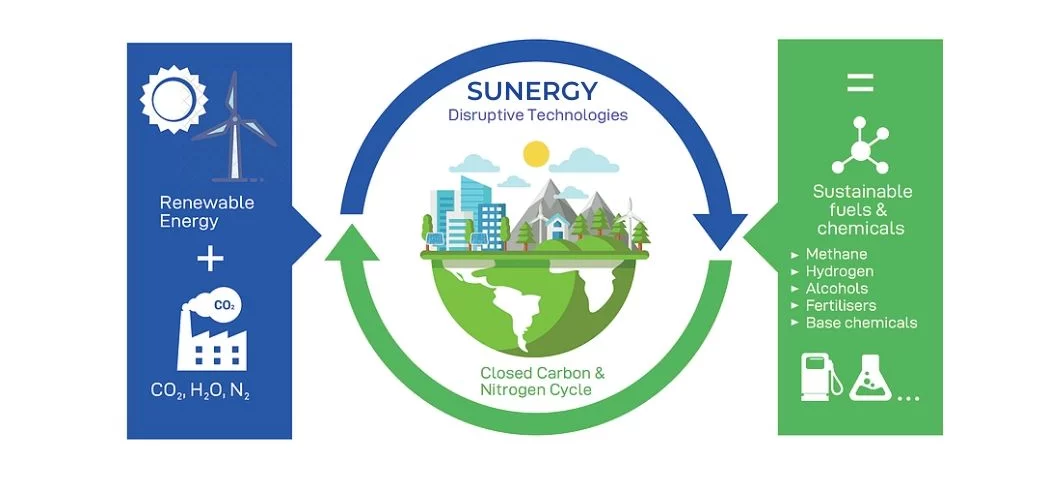
4 M€ grant to accelerate innovation on solar fuels and chemicals, and to support the transition toward a fossil-free EU economy
Jun 2, 2022 | News, SUNER-C
To mitigate climate change, our society must reduce its greenhouse gas emissions and find solutions to move away from fossil resources, while undergoing a gradual transition from a linear to a circular economy. To this end, the deployment of renewable energy needs to be supplemented with technologies for the large-scale production of sustainable chemical energy carriers such as green hydrogen and carbon-based fuels and chemicals. This is necessary to efficiently store renewable energy, supply fuels to sectors and processes that are difficult to electrify, and create non-fossil carbon feedstock for the chemical industry. In fact, solar energy can be used to transform abundantly available compounds such as carbon dioxide, water and nitrogen into renewable fuels, materials and chemicals. These so-called solar fuels and chemicals are most often analogous to their fossil counterparts and can be incorporated into the existing energy value chains with minimal adjustments to the existing infrastructure. Thus, solar fuels provide drop-in solutions to help society to transition toward circularity, increase Europe’s energy sovereignty and the reduction of greenhouse gas emissions.
To accelerate innovation in the sector of solar fuels and chemicals, the 3-year SUNER-C programme entitled “SUNERGY Community and eco-system for accelerating the development of solar fuels and chemicals” has been funded by the European Union (EU). The SUNER-C consortium is a unique and balanced partnership of 31 organisations, bringing together a large diversity of partners, expertise, fields, and representatives of all the EU regions. The consortium consists of 13 academic partners, 13 industrial companies, 4 network organisations and federations, and 1 Non-Governmental Organisation.
The overarching objective of the SUNER-C project is to create an inclusive innovation community and ecosystem that builds on the current SUNERGY network[1] and includes new stakeholders across Europe. Bringing together fundamental and applied knowledge from various sectors of the society as well as often unique resources, the enhanced community will prepare a large-scale European joint action. The goal is to overcome scientific, technological, organizational and socio-economic challenges, accelerate innovation in solar fuels and chemicals, and enable the transition of existing and future technologies from laboratory and demonstrator level to industrial-scale application.
The SUNER-C consortium will also work on the development of a strategic roadmap towards the broad implementation of solar fuels and chemicals, with supporting strategies for innovation and exploitation, with a firm focus on cross-cutting and socio-technical aspects.

Prof. Bert Weckhuysen, Distinguished University Professor at Utrecht University, said:
“We have to make our manufacturing processes for fuels, chemicals and materials more sustainable. The granted SUNER-C programme will help us to foster this important transition by bringing key players together, develop with them the necessary roadmaps, as well as lay the foundation for a large R&D initiative within Europe.”
Dr. Frédéric Chandezon, European policy officer on large renewable energy programmes at IRIG institute, CEA Grenoble, stated:
“The granting of the SUNER-C project is an excellent opportunity for SUNERGY to become a key player on the EU level in the field of solar fuels and chemicals. Together with all stakeholders active or interested in the field, this project will allow speeding up the industrial and societal uptake of solar fuels and chemicals technologies and contribute to wider and longer-term impacts of the EU for a low carbon future.”
Prof. Maximilian Fleischer, Chief Key Expert at SIEMENS Energy, commented:
“Own green raw materials for chemical products and fuels are key for our European economy to become fossil-free and less dependent of foreign resources. SUNER-C gives us the chance to align our European key competencies from academia, society and industry, to roadmap and create the critical mass to accelerate, and to make this technology development happen in a pan European R&D initiative”
